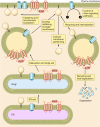The physiology of protein S-acylation
- PMID: 25834228
- PMCID: PMC4551212
- DOI: 10.1152/physrev.00032.2014
The physiology of protein S-acylation
Abstract
Protein S-acylation, the only fully reversible posttranslational lipid modification of proteins, is emerging as a ubiquitous mechanism to control the properties and function of a diverse array of proteins and consequently physiological processes. S-acylation results from the enzymatic addition of long-chain lipids, most typically palmitate, onto intracellular cysteine residues of soluble and transmembrane proteins via a labile thioester linkage. Addition of lipid results in increases in protein hydrophobicity that can impact on protein structure, assembly, maturation, trafficking, and function. The recent explosion in global S-acylation (palmitoyl) proteomic profiling as a result of improved biochemical tools to assay S-acylation, in conjunction with the recent identification of enzymes that control protein S-acylation and de-acylation, has opened a new vista into the physiological function of S-acylation. This review introduces key features of S-acylation and tools to interrogate this process, and highlights the eclectic array of proteins regulated including membrane receptors, ion channels and transporters, enzymes and kinases, signaling adapters and chaperones, cell adhesion, and structural proteins. We highlight recent findings correlating disruption of S-acylation to pathophysiology and disease and discuss some of the major challenges and opportunities in this rapidly expanding field.
Copyright © 2015 the American Physiological Society.
Figures





References
-
- Adibekian A, Martin BR, Chang JW, Hsu KL, Tsuboi K, Bachovchin DA, Speers AE, Brown SJ, Spicer T, Fernandez-Vega V, Ferguson J, Hodder PS, Rosen H, Cravatt BF. Confirming target engagement for reversible inhibitors in vivo by kinetically tuned activity-based probes. J Am Chem Soc 134: 10345–10348, 2012. - PMC - PubMed
-
- Adlanmerini M, Solinhac R, Abot A, Fabre A, Raymond-Letron I, Guihot AL, Boudou F, Sautier L, Vessières E, Kim SH, Lière P, Fontaine C, Krust A, Chambon P, Katzenellenbogen JA, Gourdy P, Shaul PW, Henrion D, Arnal JF, Lenfant F. Mutation of the palmitoylation site of estrogen receptor α in vivo reveals tissue-specific roles for membrane versus nuclear actions. Proc Natl Acad Sci USA 111: E283–290, 2014. - PMC - PubMed
Publication types
MeSH terms
Substances
Grants and funding
LinkOut - more resources
Full Text Sources
Other Literature Sources
Research Materials

